| Article ID | Journal | Published Year | Pages | File Type |
|---|---|---|---|---|
| 9451747 | Chemosphere | 2005 | 11 Pages |
Abstract
High volume air sampling in the Canadian Prairies was used to characterize atmospheric concentrations for 10 herbicides (alachlor, atrazine, ethalfluralin, metolachlor, 2,4-D, dicamba, bromoxynil, MCPA, trifluralin, and triallate) along a 500-km north-south transect. Atmospheric concentration measurements at various altitudes identified that of the six herbicides present in the highest concentrations, triallate was strongly influenced by local sources, while 2,4-D, dicamba, bromoxynil, MCPA and trifluralin were dominated by regional atmospheric transport. Concentrations of the herbicides measured at various altitudes were compared with dry deposition rates measured using a dry/wet deposition sampler and used to calculate deposition velocities Vd. The primary atmospheric transport mechanism for MCPA and bromoxynil was shown to be adsorption to particles dispersed in the atmosphere, with the same mechanism also confirmed for 2,4-D and dicamba, while trifluralin was shown to be transported mainly in the gas phase. This method of calculation indicated that transportation of triallate was influenced by particle adsorption. Weekly maximum atmospheric loadings of the major herbicides present in the Prairies were estimated to range from 73Â kg for trifluralin to 541Â kg for 2,4-D.
Keywords
Related Topics
Life Sciences
Environmental Science
Environmental Chemistry
Authors
D.T. Waite, P. Bailey, J.F. Sproull, D.V. Quiring, D.F. Chau, J. Bailey, A.J. Cessna,
